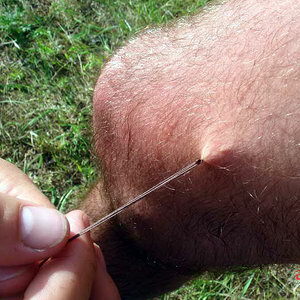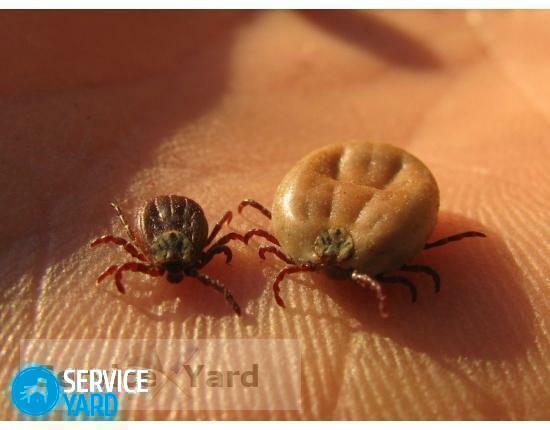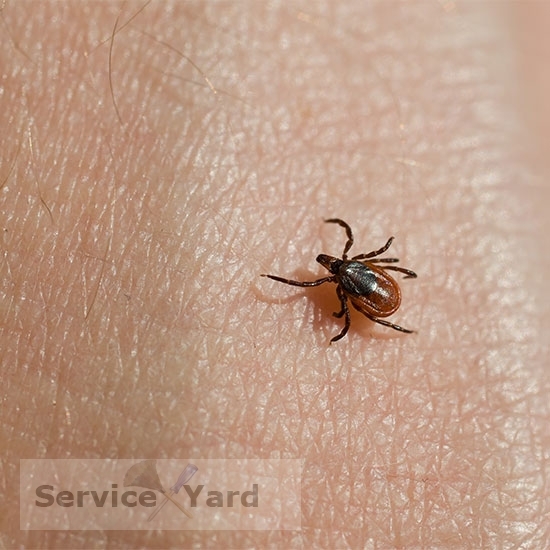
- Description of
- ticks How to remove a tick at home?
- What can not be done while removing a parasite?
- Useful advices:
- Prevention methods
With the onset of spring, many people seek to forest with their pets and become easy prey for ticks. Victim can become you or a loved one, as well as animals. If the insect has started its paws under your skin, you must act carefully and according to the rules, having previously familiarized yourself with how to remove the tick at home.
to content ↑Description of
parasites One of the most ancient arthropods on earth is a tick. More than 48,000 species are currently described. Such a great flowering arthropod reached in connection with the fact that in the course of its historical development, they acquired microscopic dimensions. This allowed them to master all layers of soil, rich in plant remains.
Only a few species of ticks from the whole variety are parasites feeding on the blood of warm-blooded animals and humans. The most famous of them are ixodid mites. These insects are dangerous because they carry a lot of dangerous diseases through bites, in particular:
- Borreliosis( Lyme disease).
- Tick-borne encephalitis.
Important! The tick has microscopic dimensions( 2-4 mm), flattened, in the horizontal plane, and a very thin red-brownish corpuscle. But having poured blood, the tick can grow in sizes up to 1 cm and acquire a globular shape. The color changes to light gray. Absorb blood arthropod can tens of times its weight.
Ticks have no eyes, but this defect is compensated by a fine sense of smell. The insect can smell the victim at a distance of up to 10 m. Hanging on the tips of grass or twigs, ticks wait for their prey and cling to the clothes of people passing by or the animal's hair.
 You can detect them already on the shoulders, neck or head, as the insects creep too well in search of a place for a bite. Parasites try to suck in places with a thin skin and good blood supply. Usually it is:
You can detect them already on the shoulders, neck or head, as the insects creep too well in search of a place for a bite. Parasites try to suck in places with a thin skin and good blood supply. Usually it is:
- Hairy part of head.
- Axillary hollows.
- Neck.
- Ear tips.
- Abdomen.
Finding a suitable place, the parasite firmly grasps the paws in the skin of the victim and pierces it with a proboscis. A person or animals do not feel a bite, since the parasite's saliva contains anesthetic substances. In addition, the saliva of the tick prevents the blood from clotting the victim, thereby allowing the arthropod to freely suck it.
The mite, like a borer, is screwed under the skin, and if you start to pull out and remove it illiterately, some of the insect may get stuck inside. This increases the risk of infection. The procedure for removal is a nasty business, but painless if you follow the instructions exactly how to remove the tick at home.
to the contents ↑How to remove the tick at home?
There are several methods of getting rid of parasites, but the procedure must be done carefully and carefully so as not to tear off the proboscis or the head of the mite. Left in the skin, they will cause inflammation.
See some ways to get rid of the tick and choose the one for which you can safely execute the points.
Method number 1.With tweezers or surgical clamp
If you already have the preliminary skills to remove various bloodsuckers from your body, try to act as fast as possible to remove the tick at home. To do this:
- Grab the tick with tools as close as possible to the proboscis.
- Pull it lightly up, while rotating( as it were, twisting) the mite in any direction.
- After 1-3 turns, the arthropod is removed from the wound along with the proboscis.
Important! Do not try to just pull the parasite out of the skin, as it can burst. Do not grab the mite on the ground so as not to break or crush it, otherwise - you will inject toxins into the bloodstream.
Method number 2.Using a coarse thread or a thin lace
Another option of how you can act to remove a tick at home includes the following items:
- On an insect, cover the eyelet with a coarse thread or a thin lace.
- Grab the tick as close as possible to the proboscis. To do this, pre-stretch the skin with your fingers.
- Tighten the loop, gently swinging from side to side or twisting counter-clockwise, slowly pull out the parasite.
Method number 3.With the help of special tools
Currently, special tools are available for removing ticks. For example, Kinver, Tick Nipper and others. Sold devices in the pharmacy and are a two-pronged curved fork. To remove the parasite, this hook hooks it in such a way that it is between the teeth, and then gently unscrew the bloodsucker from the skin.
Advantages of special tools:
- Do not squeeze the body of the mite and, thus, do not give into the blood of infection.
- Allow to extract the parasite completely, together with the proboscis.
- Provided with a special test tube for insect delivery for analyzes.
What can not be done when removing a parasite?
 No matter how difficult your problem seems, how to remove a tick at home, how quickly you notice it and other factors, do not ever do the following:
No matter how difficult your problem seems, how to remove a tick at home, how quickly you notice it and other factors, do not ever do the following:
- You can not pour a mite on caustic liquids: ammonia, gasoline, vinegar, etc.
- You can not cauterize the parasite with the tip of a cigarette.
- You can not pull out the tick, try to squeeze it and poke around in the wound with a dirty, untreated needle.
- Do not apply compresses to the bite, as this will worsen the situation and will not save you from possible infection.
Useful advices:
- If you have found a sucking parasite in the forest, but no suitable tools, then use an ordinary needle or pin. It is advisable to treat the instrument with alcohol.
- After removal of the insect, the wound must be treated with antiseptic: iodine, zelenok, alcohol, etc.
- After use, wash all instruments and hands thoroughly.
- If the tick is alive after the extraction, then place it in a jar and take it to a medical institution for examination for infection with viruses. If you have removed the parasite in the forest, it is better to burn it.
- If part of the tick is deeply ingrained under the skin and the proboscis protrudes above the surface of the skin, then remove it by holding it with tweezers or contact the surgeon at the clinic. If a part of the proboscis remains, a small pustule can form in this area in a short time, and after a while the remnants of the parasite will come out together with pus.
- Before sending to the forest, prepare the necessary means: take a first aid kit with you and treat the clothing with special means that repel ticks.
- Many doctors do not recommend using the parasite strangulation method, that is, treating it with vegetable oil. Blockage of the respiratory tract of the tick can lead to its death immediately under the skin, and the parasite will have time to inject the poison into the wound.
Methods of prevention
To avoid this problem as rarely as possible, observe preventive measures. They are not complicated, but they allow themselves to be secured:
- Before you go to the country, on a robot for a city or a forest, vaccinate against tick-borne encephalitis for yourself and your pets. The first vaccination is done one and a half months before the departure, and a month later you need to make a second injection and only after 14 days from the second vaccination you can safely leave for the city.
Important! In emergency cases, if a person does not manage to pass the vaccination course, then he is injected with human immunoglobulin, which will begin to function in 24-48 hours and will work for about 4 weeks.
- If you did not get vaccinated by going to rest in places where there may be parasites, dress in such a way that there are no open areas of the body:
- Clothing should be light tones with long sleeves and a collar.
- Sweatshirts, shirts in the trousers.
- Pants tuck into boots, boots or socks.
- The cuffs on the sleeves are fastened or strapped with ribbons.
- Tie the neck with a handkerchief.
- Put a hat or handkerchief on your head.
- Upon returning home after a holiday in the nature, carefully inspect the clothes, as well as the bodies of their loved ones and pets.
- When relaxing in nature, use insect repellent repellents. Treat them with open areas of the body and clothing.
Many experts believe that it is not worthwhile to extract the mite yourself, especially if there is an opportunity to quickly get into a medical facility. Of course, it is better if specialists remove the parasite, as the body of the tick is fragile enough and its head can come off. This leads very often to infection. In addition, the study of an insect without a head in the laboratory is difficult, and not every laboratory in this case can establish the presence of infection.
But no one knows in what conditions "arthropod" attacked you, so we hope that thanks to our advice, you will choose the most suitable and acceptable way of removing the tick. And in order not to tempt fate, adhere to preventive measures, going to the recreation area. Take care of yourself, your loved ones, as well as pets from parasites!

